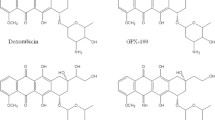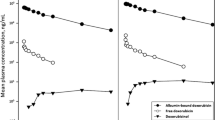Summary
Bisantrene (NSC 337766) is an anthracenedicarboxaldehyde hydrazone demonstrating a wide spectrum of activity in animal tumor model systems with no evidence of cardiotoxicity or alopecia, in contrast to doxorubicin. Thirty-three women with advanced adenocarcinoma of the breast were treated with 260 mg/m2 IV every 3 weeks. All patients had received at least one prior combination chemotherapy regimen for metastatic disease and 32/33 were refractory to doxorubicin. Of 28 patients evaluable for response one had a partial response lasting 10 weeks and three patients had stable disease for 22, 22, and 9 weeks. The most significant toxicities were nonhematologic: nausea and vomiting (41%), phlebitic reactions (38%), hypotension, one fatal anaphylactic reaction, and the development of a 7th cranial nerve palsy during drug infusion. Hematologic toxicity, leukopenia, was dose-limiting but manageable without associated infections or bleeding. These results indicate that bisantrene in this dose and schedule is not a useful drug in heavily pretreated breast cancer patients. The incidence and severity of phlebitic reactions limited venous access and adversely affected patient compliance. Preliminary results of other phase II breast cancer trials indicate a similar spectrum of toxicity but suggest more significant antitumor activity even in patients previously treated with doxorubicin. Trials conducted in patients with minimal prior treatment and with bisantrene administered via central line appear warranted for definitive assessment of the activity of this agent in breast cancer.
Similar content being viewed by others
References
Alberts DS, Mackel C, Pocelinko R, Salmon SE (1982) Phase I clinical investigation of 9,10-anthracenedicarboxaldehye-bis [(4,5-dihydro-1H-imidazol-2-yl)hydrozane] dichloride with correlative in vitro human tumor clonogenic assay. Cancer Res 42:1170
Cavalli F, Claryse A, Bakkel Huinink WT, Clavel HM, Van Glabbeke M, Rozencweig M (1983) Phase II study of bisantrene in advanced breast cancer. Proc Am Soc Clin Oncol 2:C-441
Chang AY, Falkson G, Kaplan BH, Skeel RT, Muggia FM, Pandya KJ (1983) Phase II study of bisantrene (9,10 anthracene dicarboxaldehyde Cl 216,942) in patients with refractory breast cancer. Proc Am Soc Clin Oncol 2:C-385
Citarella RV, Wallace RE, Murdock KC, Angier RB, Durr FE, Forbes M (1982) Activity of a novel anthracenyl bishydrazone, 9,10-anthracendicarboxaldehyde-bis[(4,5-dihydro-1H-imidazol-2-yl]hydrazone) dichloride, against experimental tumors in mice. Cancer Res 42:440
Medical Research Division, American Cyanamid Co. (1979) Investigators brochure: CL 216,942-9,10-anthracenedicarboxaldehyde bis-[(4,5-dihydro-1H-imidazol-2-yl)hydrazone] dihydrochloride. American Cyanamid, Pearl River
Myers JW, Von Hoff DD, Coltman CA Jr, Kuhn JG, Van Echo D, Rivkin S, Pocelinko R (1982) Phase II evaluation of bisantrene (CL 216,942) in advanced renal cell carcinoma. Cancer Treat Rep 66:1869
Myers JW, Von Hoff DD, Kuhn JG, Osborne CK, Sandbach JF, Pocelinco R (1983) Anaphylactoid reactions associated with bisantrene infusions. Investigational New Drugs 1:85
Osborne CK, Von Hoff DD, Cowan JD, Sandbach J (1984) Bisantrene, an active drug in patients with advanced breast cancer. Cancer Treat Rep 68:357
Sparano BM, Gordon GH, Hall C, Iatropoulos MJ, Noble TF (1980) Assessment of cardiotoxic potential of a new anticancer compound, an anthracenebishydrazone derivative in beagle dogs: comparison with Adriamycin: In: Abstracts of the 20th Interscience Conference on Antimicrobial Agents and Chemotherapy, Abstract #31
Spiegel RJ, Blum RH, Levin M, Pinto CA, Wernz JC, Speyer JL, Hoffman KS, Muggia FM (1982) Phase I clinical trial of 9,10-anthracenedicarboxaldehyde (bisantrene) administered in a five-day schedule. Cancer Res 42:354
Von Hoff DD, Myers JW, Kuhn J, Sandbach JF, Pocelinko R, Clark G, Coltman CA (1981a) Phase I clinical investigation of 9–10 anthracenedicarboxaldehyde-bis[(4,5-dihydro-1H-imidazol-2-yl) hydrazone] dihydrochloride (CL 216,942). Cancer Res 41:3118
Von Hoff DD, Coltman CA Jr, Forseth B (1981b) Activity of 9,10-anthracenedicarboxaldehye-bis[(4,5-dihydro-1H-imidazol-2-yl)hydrazone] dichloride (CL 216,942) in a human tumor cloning system. Leads for phase II trials in man. Cancer Chemother Pharmacol 6:141
Yap H, Yap B, Blumenschein GR, Barnes BC, Schell FC, Bodey GP (1983) Bisantrene, and active new drug in the treatment of metastatic breast cancer. Cancer Res 43:1402
Author information
Authors and Affiliations
Additional information
Support in part by NCI Grants-CA 31983, CA 31946, CA 16118, CA 12449, CA 33601
Rights and permissions
About this article
Cite this article
Forastiere, A.A., Perry, M.C., Hughes, A.K. et al. Bisantrene (NSC 337766) (CL 216,942) in advanced breast cancer. Cancer Chemother. Pharmacol. 13, 226–229 (1984). https://doi.org/10.1007/BF00269035
Received:
Accepted:
Issue Date:
DOI: https://doi.org/10.1007/BF00269035




